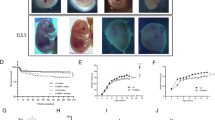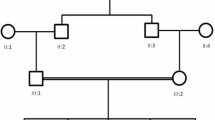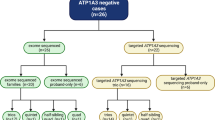Abstract
The exceptionally large SYNE1 (spectrin repeat-containing nuclear envelope protein 1) gene encodes different nesprin-1 isoforms, which are differentially expressed in striated muscle and in cerebellar and cerebral neurons. Nesprin-1 isoforms can function in cytoskeletal, nuclear, and vesicle anchoring. SYNE1 variants have been associated with a spectrum of neurological and neuromuscular disease. Homozygosity mapping combined with exome sequencing identified a disease-causing nonsense mutation in the ultimate exon of full-length SYNE1 transcript in an 8-year-old boy with distal arthrogryposis and muscular hypotonia. mRNA analysis showed that the mutant transcript is expressed at wild-type levels. The variant truncates nesprin-1 isoforms for the C-terminal KASH (Klarsicht-ANC-Syne homology) domain. This is the third family with recessive arthrogryposis caused by homozygous distal-truncating SYNE1 variants. There is a SYNE1 genotype–phenotype correlation emerging, with more proximal homozygous SYNE1 variants causing recessive cerebellar ataxia of variable onset (SCAR8; ARCA-1).
Similar content being viewed by others
Log in or create a free account to read this content
Gain free access to this article, as well as selected content from this journal and more on nature.com
or
References
Randles KN, Lam le T, Sewry CA et al: Nesprins, but not sun proteins, switch isoforms at the nuclear envelope during muscle development. Dev Dyn 2010; 239: 998–1009.
Rajgor D, Shanahan CM : Nesprins: from the nuclear envelope and beyond. Expert Rev Mol Med 2013; 15: e5.
Duong NT, Morris GE, Lam le T et al: Nesprins: tissue-specific expression of epsilon and other short isoforms. PLoS ONE 2014; 9: e94380.
Mislow JM, Kim MS, Davis DB, McNally EM : Myne-1, a spectrin repeat transmembrane protein of the myocyte inner nuclear membrane, interacts with lamin A/C. J Cell Sci 2002; 115: 61–70.
Razafsky D, Hodzic D : A variant of Nesprin1 giant devoid of KASH domain underlies the molecular etiology of autosomal recessive cerebellar ataxia type I. Neurobiol Dis 2015; 78: 57–67.
Attali R, Warwar N, Israel A et al: Mutation of SYNE-1, encoding an essential component of the nuclear lamina, is responsible for autosomal recessive arthrogryposis. Hum Mol Genet 2009; 18: 3462–3469.
Laquerriere A, Maluenda J, Camus A et al: Mutations in CNTNAP1 and ADCY6 are responsible for severe arthrogryposis multiplex congenita with axoglial defects. Hum Mol Genet 2014; 23: 2279–2289.
Noreau A, Bourassa CV, Szuto A et al: SYNE1 mutations in autosomal recessive cerebellar ataxia. JAMA Neurol 2013; 70: 1296–1331.
Gros-Louis F, Dupre N, Dion P et al: Mutations in SYNE1 lead to a newly discovered form of autosomal recessive cerebellar ataxia. Nat Genet 2007; 39: 80–85.
Cartwright S, Karakesisoglou I : Nesprins in health and disease. Semin Cell Dev Biol 2014; 29: 169–179.
Fogel BL, Lee H, Deignan JL et al: Exome sequencing in the clinical diagnosis of sporadic or familial cerebellar ataxia. JAMA Neurol 2014; 71: 1237–1246.
Synofzik M, Smets K, Mallaret M et al: SYNE1 ataxia is a common recessive ataxia with major non-cerebellar features: a large scale multi-centre study. Brain 2016; 139: 1378–1393.
Ikeda Y, Dick KA, Weatherspoon MR et al: Spectrin mutations cause spinocerebellar ataxia type 5. Nat Genet 2006; 38: 184–190.
van de Leemput J, Chandran J, Knight MA et al: Deletion at ITPR1 underlies ataxia in mice and spinocerebellar ataxia 15 in humans. PLoS Genet 2007; 3: e108.
Dupre N, Gros-Louis F, Chrestian N et al: Clinical and genetic study of autosomal recessive cerebellar ataxia type 1. Ann Neurol 2007; 62: 93–98.
Hamza W, Ali Pacha L, Hamadouche T et al: Molecular and clinical study of a cohort of 110 Algerian patients with autosomal recessive ataxia. BMC Med Genet 2015; 16: 36.
Izumi Y, Miyamoto R, Morino H et al: Cerebellar ataxia with SYNE1 mutation accompanying motor neuron disease. Neurology 2013; 80: 600–601.
Puckelwartz MJ, Kessler EJ, Kim G et al: Nesprin-1 mutations in human and murine cardiomyopathy. J Mol Cell Cardiol 2010; 48: 600–608.
Zhang Q, Bethmann C, Worth NF et al: Nesprin-1 and -2 are involved in the pathogenesis of Emery Dreifuss muscular dystrophy and are critical for nuclear envelope integrity. Hum Mol Genet 2007; 16: 2816–2833.
Fanin M, Savarese M, Nascimbeni AC et al: Dominant muscular dystrophy with a novel SYNE1 gene mutation. Muscle Nerve 2015; 51: 145–147.
Mislow JM, Holaska JM, Kim MS et al: Nesprin-1alpha self-associates and binds directly to emerin and lamin A in vitro. FEBS Lett 2002; 525: 135–140.
Zhang X, Xu R, Zhu B et al: Syne-1 and Syne-2 play crucial roles in myonuclear anchorage and motor neuron innervation. Development 2007; 134: 901–908.
Puckelwartz MJ, Kessler E, Zhang Y et al: Disruption of nesprin-1 produces an Emery Dreifuss muscular dystrophy-like phenotype in mice. Hum Mol Genet 2009; 18: 607–620.
Schuurs-Hoeijmakers JH, Vulto-van Silfhout AT, Vissers LE et al: Identification of pathogenic gene variants in small families with intellectually disabled siblings by exome sequencing. J Med Genet 2013; 50: 802–811.
Green EK, Grozeva D, Forty L et al: Association at SYNE1 in both bipolar disorder and recurrent major depression. Mol Psychiatry 2013; 18: 614–617.
Meinke P, Mattioli E, Haque F et al: Muscular dystrophy-associated SUN1 and SUN2 variants disrupt nuclear-cytoskeletal connections and myonuclear organization. PLoS Genet 2014; 10: e1004605.
Author information
Authors and Affiliations
Corresponding author
Ethics declarations
Competing interests
The authors declare no conflict of interest.
Supplementary information
Rights and permissions
About this article
Cite this article
Baumann, M., Steichen-Gersdorf, E., Krabichler, B. et al. Homozygous SYNE1 mutation causes congenital onset of muscular weakness with distal arthrogryposis: a genotype–phenotype correlation. Eur J Hum Genet 25, 262–266 (2017). https://doi.org/10.1038/ejhg.2016.144
Received:
Revised:
Accepted:
Published:
Issue date:
DOI: https://doi.org/10.1038/ejhg.2016.144
This article is cited by
-
Whole-exome sequencing uncovers the genetic basis of hereditary concomitant exotropia in ten Chinese pedigrees
BMC Medical Genomics (2025)
-
Extending the Mutational Spectrum of SYNE1 Ataxia in Chinese Patients
The Cerebellum (2025)
-
First report of SYNE1 arthrogryposis multiplex congenita from Saudi Arabia with a novel mutation: a case report
Italian Journal of Pediatrics (2022)
-
TTN as a candidate gene for distal arthrogryposis type 10 pathogenesis
Journal of Genetic Engineering and Biotechnology (2022)
-
Novel Homozygous Truncating Variant Widens the Spectrum of Early-Onset Multisystemic SYNE1 Ataxia
The Cerebellum (2022)



